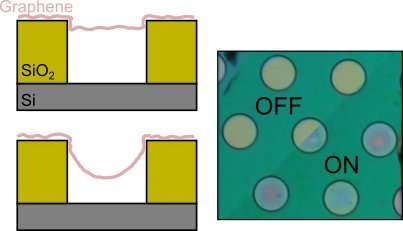

| Date | 16th, Nov 2018 |
|---|
 Graphene mechanical devices of 5µm in diameter are used as continuous-spectrum pixels in a reflective-type display of 2500 ppi (pixels per inch). When the GIMOD prototype is OFF (ON), the pixels have a yellow (blue) color. Credit: Dr. Santiago Jose Cartamil-Bueno
Graphene mechanical devices of 5µm in diameter are used as continuous-spectrum pixels in a reflective-type display of 2500 ppi (pixels per inch). When the GIMOD prototype is OFF (ON), the pixels have a yellow (blue) color. Credit: Dr. Santiago Jose Cartamil-Bueno
With virtual reality (VR) sizzling in every electronic fair, there is a need for displays with higher resolution, frame rates and power efficiency. Now, a joint collaboration of researchers from SCALE Nanotech, Graphenea and TU Delft have used graphene to make reflective-type displays that operate faster and at much higher resolution than existing technologies.
Displays consume the most power in electronic gadgets. Portable devices like smartphones and VR visors therefore require most of the energy from batteries. As an alternative solution, reflective-type displays (like those in e-book readers) consume little power, though they cannot deliver video. Reflective displays that offer the specifications of standard technologies (OLED, LCD) do not exist yet. The good news is that graphene makes this possible.
Graphene, a monolayer of carbon atoms, is the thinnest, strongest material and the best electrical conductor, an ideal combination for micro-electromechanical systems (MEMS). Membranes in a graphene MEMS can be moved by applying an electric potential and, together with the large optical absorption of graphene (2.3 percent of visible light), the researchers used them to make a Graphene Interferometric MOdulator Display or simply GIMOD.
